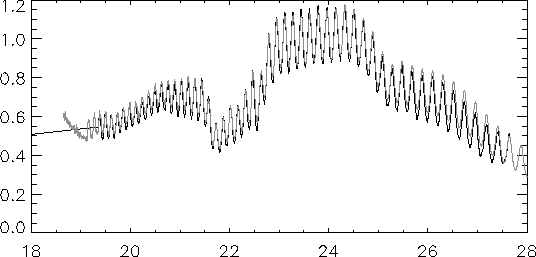
Figure 4: The RSRF for band 1A based on a measurement of HR7001 (black) versus the RSRF as measured in the lab (grey) The fringes in the in-orbit-RSRF are real.

Figure 4: The RSRF for band 1A based on a measurement of HR7001
(black) versus the RSRF as measured in the
lab (grey) The fringes in the in-orbit-RSRF are real.

Figure 5: The RSRF for band 1A based on a measurement of HR7001
(black) and the
lab RSRF corrected to the overall shape of the in-orbit RSRF. Note that not
every feature that was seen in the lab has been seen in orbit. Especially
the differences in the 2.35 - 2.40 region are relatively large. Similar
features seen in SWS spectra might be not real.

Figure 6: The RSRF for band 1b based on a measurement of HR7001 versus
the lab RSRF (grey). The fringes in the in-orbit-RSRF are real.

Figure 7: The RSRF for band 1d based on a measurement of HR7001 versus
the lab RSRF (grey) The fringes in the in-orbit-RSRF are real.

Figure 8: The RSRF for band 1e based on a measurement of HR7001 versus
the lab RSRF (grey) The fringes in the in-orbit-RSRF are real.

Figure 9: The RSRF for band 2a based on a measurement of HR7001 versus
the lab RSRF (grey) The fringes in the in-orbit-RSRF are real.

Figure 10: The RSRF for band 2A based on a measurement of HR7001
(black) and the lab RSRF corrected to the overall shape of the in-orbit RSRF.

Figure 11: The RSRF for band 2b based on a measurement of HR7001 versus
the lab RSRF (grey). Also in this band the lab measurements seem to show
leakage. Attempts to correct the overall shape did not survive cross-checks
with other calibration sources yet.

Figure 12: The RSRF for band 2c based on an AOT1 speed 4 measurement of
HR5340 (black) versus the lab RSRF (grey). The CUS observation on HR7001 for
ap3 has not been done yet. The small features between 7 and 8 microns and
around 10 microns can introduce misleading features after incorrect dark.
The increase in response beyond 12 microns has been seen in other sources too.

Figure 13: The RSRF for band 3a based on a measurement of NML-CYG versus
the lab RSRF (grey). Good match, even on fringe level. The fringes are
a little 'sharper' in the in-orbit RSRF because of the limited resolution
of the lab measurements. Wrong dark subtraction will produce a lot of junk.

Figure 14: The RSRF for band 3c based on a measurement of NML-CYG versus
the lab RSRF (grey). Good match, even on fringe level. The fringes are
a little 'sharper' in the in-orbit RSRF because of the limited resolution
of the lab measurements. Wrong dark subtraction will produce a lot of junk.

Figure 15: The RSRF for band 3d based on a measurement of NML-CYG versus
the lab RSRF (grey). Good match, even on fringe level. The fringes are
a little 'sharper' in the in-orbit RSRF because of the limited resolution
of the lab measurements. Wrong dark subtraction will produce a lot of junk.

Figure 16: The RSRF for band 3e based on a measurement of NML-CYG versus
the lab RSRF (grey). Good match, even on fringe level.
Wrong dark subtraction will produce beautiful fringes.

Figure 18: The RSRF for band 4 based on a measurement of NML-CYG versus
the lab RSRF (grey). Since the model of NML-CYG is only within 30%
accurate, it is not clear if the in-orbit RSRF is really different from
the lab RSRF.

Figure: The RSRF for band 4 based on an AOT1 speed 4 measurement of
ETA-CAR versus the lab RSRF (grey).